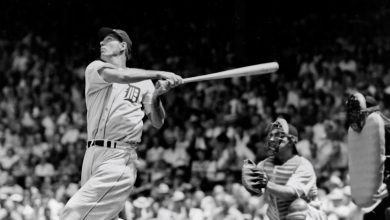Do footy’s best and fairest awards achieve what they claim?

مجلة المذنب نت متابعات عالمية:
Football’s awards season kicks off this week, with the AFL’s Brownlow Medal awarded on Monday evening and the NRL’s Dally M awarded on October 2.
Both medals aim to crown their league’s best regular season player.
Historical voting patterns, however, question whether they achieve this objective, or rather award the most influential key position player from the season’s most successful teams.
How to assess a fairest and best player?
A curiosity of the Australian sport landscape is that all four major football codes use a different panel of judges in award voting.
The AFL’s Brownlow Medal is voted on by umpires, while the NRL’s Dally M is determined by a pool of media pundits and ex-players.
Rugby Australia’s John Eales Medal is voted on by players, and the A-League’s Johnny Warren Medal is judged by a four-body panel that consists of a technical football expert, football media representative, former player and match officials.
Each one of these structures produces unique biases and criticisms.
The Brownlow: the midfielder’s medal
The Brownlow was devised as an award for the fairest and best player of the AFL competition, reflecting the often understated importance of fair play that umpires are uniquely positioned to judge.
The Brownlow’s voting system has long been a topic of interest for fans, pundits and academics alike.
While Lachie Neale’s surprise victory in 2023 generated renewed controversy, the Brownlow has long been criticised as a midfielders award.
Melbourne’s Herald, in 1938, stated:
Under the present method, men playing on the full-forward or full-back lines have little chance of winning the award usually being won by men most constantly in the play who are able to stand out in comparatively weak sides.
This observation around weak sides reflected that from 1931 to 1938, the Brownlow went on an eight-season run of being won by a player not from a finals team.
Indeed, among the first 49 Brownlow winners from 1924 to 1969, only 31% came from finalists.
Since 1970, 72% of winners have come from a finals team (noting the finals system has changed over time).
One consistent long-term trend has been the dominance of midfielders.
Among the 27 Brownlows awarded this millennium, only Adam Goodes (a two-time winner) would not be considered primarily a midfielder.
This positional dominance is not unique to AFL.
Soccer’s most pre-eminent global award, the Ballon d’Or, has been awarded 66 times, of which a defender has been the recipient only four times and a goalkeeper once.
The Dally M suffers from a similar concentration.
The Dally M: the media medal
The Dally M has been awarded since 1979, becoming rugby league’s premier individual honour in 1998 with the formation of the NRL.
In 45 years of voting, the winner has come from a non-finalist team on only six occasions (13%).
The award is also won near exclusively by the “spine” positions of fullback, five-eighth, halfback and hooker, which account for 91% of medallists.
The Dally M uses a pool of media pundits and ex-players for voting on each match, creating the potential for obvious conflicts of interests.
During seasons 2019 and 2020 for instance, 12 of the Brisbane Broncos’ 44 matches were judged by ex-Broncos players. On four of these instances, former player Darren Lockyer was the judge, despite being an active non-executive director of the Brisbane Broncos organisation.
Voting in nearly 22% of matches in these two seasons was performed by judges who played or coached for one of the participating teams.
NRL Chairman Peter V’Landys initiated a review of the Dally M following a surprise winner in 2020 (Jack Wighton), claiming the voting system disadvantaged players from winning teams.
Whilst this supposition disregarded that 88% of all 2020 Dally M points were awarded to players from the winning team, voting was modified for the 2023 season.
This revised system introduced an additional judge to produce two independent voters per match, and in a widely criticised move, veiled these judges with anonymity.
This new system has revealed just how little experts agree when trying to assess subjective performance.
In the opening five rounds of 2023, the two judges picked the same player of the match in less than half (48%) of fixtures.
In a third of matches (31%), one judge’s best on ground did not poll any points with the other judge.
In one instance, the two judges chose six completely different players in their respective 3-2-1 votes (round five, 2023, Bulldogs v Cowboys).
Player and coach awards: The true best and fairest?
Although the Brownlow and Dally M dominate the public limelight, team accolades are typically held in high standing within sport clubs, as internal recognition is often more highly valued than external status within high performance cultures.
Such player and coach awards, typically forming part of season-end club events, can be argued as more accurate assessments of player performance.
This is because the voters – teammates and/or coaches – best understand the roles and expectations of each player within the team’s overarching game plan.
For this reason, in the AFL, there is often wide discrepancies between a team’s distribution of Brownlow votes and a club’s internal award votes.
In 2023, for instance, six of 18 AFL clubs crowned a best and fairest who was different from their highest Brownlow vote-getter.
The most notable of this was Brisbane, where key defender Harris Andrews won the club’s best and fairest, despite finishing 44th in Brownlow voting.
Defender Harry Sheezel similarly won North Melbourne’s best and fairest despite finishing fifth from his team in the Brownlow count.
Is there a perfect solution?
Recent shock winners in both codes saw media organisations perform “forensic analysis” of voting patterns.
In the AFL, former Collingwood president and media personality Eddie McGuire proposed a “panel of elders” while the NRL’s V’Landys proposed rating every player for every match, to determine their respective awards.
Such scrutiny has undoubtedly been fuelled by the datafication of sport and its athletes, which has seen player performance statistics enter the sporting mainstream.
Is it notable then that the AFL reaffirmed their existing policy in early 2024 to preclude umpires from accessing player statistics in casting their votes.
Indeed statistics may not offer the perfect solution some believe.
Any statistical assessment of player performance remains underpinned by human judgement as to the importance of each metric, whilst missing the qualitative nuance that surrounds key match plays and moments.
Ultimately then, there may not be a perfect method to determine a league’s best and fairest player and, arguably, it is this human judgement dimension which makes these awards so engaging as a public spectacle.
نشكركم على قراءة المنشور عبر مجلة المذنب نت, المتخصصة في التداول والعملات الرقمية والمشفرة














